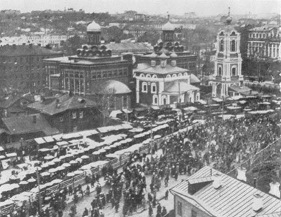By Plan B Writer’s Alliance – http://www.LocustsOnTheHorizon.com
(This is an excerpt from the book ‘Locusts on the Horizon‘ from the chapter titled ‘Meet the Beast’. This was written with mid-2012 gold prices. Even though gold has dropped in speculative price lately, due to the dropping value of the dollar and high international demand, it will go back up.)
Sometimes, famine is caused by times of crisis when those who are in power start shipping so much of the remaining food off to keep themselves, their troops, and their enforcers fed that those who are not vital to keeping their regime in power become disposable.
In early 1917, Czar Nicholas II of Russia abdicated his throne, and his appointed successor, Grand Duke Michael, declined to accept the throne until the people were allowed to vote through a Constituent Assembly to decide whether to continue the monarchy or create a democratically elected republic.
Lenin’s Communists had other ideas. In October 1917, they staged a coup in the capital of Russia and deposed the legislature.
However, that was only the beginning. Russia still had a lot of people who opposed the Communists, aka the ‘Reds’, including whole armies (the ‘White’ armies). So began the nightmare of the Russian Civil War which killed 7 million people. Of those 7 million deaths, roughly 5 million were from starvation.
Even though parts of the Russian Empire had been considered to be some of the great bread baskets of the world, both the continuance of large scale agriculture, and the distribution of its output, was badly disrupted.
Some places under control of the ‘White’ armies or the allied expeditionary forces sent into Russia (which included American troops) still had supplies coming in from the West. However, in areas under Communist control, what little there was in cities like Moscow usually got shipped off to feed the Red Army, or feed the elite who were running things and the local enforcers which kept them in power.
As the war raged on, famine was becoming a growing concern for everyone across a country which spanned eleven time zones. Cannibalism was becoming a problem in some places and the public execution of cannibals who were caught didn’t seem to stop the practice.
In Moscow during the winter of 1919-1920, the food situation was so bad that Lenin and his Communists allowed the continued existence of a large open air black market bazaar which everyone called the ‘Sukharevka’. The Communist government didn’t shut the Sukharevka down until 1925.
The Sukharevka, 1920, there were no stalls or booths. The trading and deals were simply hand to hand.
One journalist described the Sukharevka that winter as “a crowded study in need and greed”, where ANYTHING could be had – for a price. Even Lenin admitted that without the Sukharevka, Moscow would have starved to death that winter.
The only cash tendered at the Sukharevka was either barter, or gold and silver. Gold and silver got you much more bang for your buck than barter. If all you had was barter, you were basically at the mercy of the food merchants who always got what you had for a small fraction of its worth.
However, even those with gold and silver (usually Imperial coins denominated in rubles minted during the Czarist era) found that the prices were astronomical.
In the fall of 1919, a single pud (1 pud = 36 US pounds) of flour cost between 6,000 to 7,000 gold rubles.
A late Czarist era 5 ruble gold coin was .900 fine and contained .1245 troy ounces of gold. So, 6000 gold rubles would be 1200, five ruble gold coins, at .1245 ounces of gold per coin. At a price of 6000 gold rubles per pud, that’s the equivalent of 4.15 troy ounces of gold per US pound of flour. In modern exchange, with gold in mid-2012 fluctuating around $1600 per ounce, that’s around $6,600 in current US dollars per pound of flour, payable only in gold or silver, and that was before the real winter even set in.
In mid-November 1919, one man reported that he was able to buy 10 eggs and 4 pounds of soap for 1000 gold rubles (24.9 troy ounces of gold).
By mid-January millet had risen to 9,500 to 10,000 gold rubles per pud. In modern American measurements, that’s 6.57 to 6.91 troy ounces of gold per pound for millet.
Six weeks later, at the beginning of March, flour had risen to 13,000 to 15,000 gold rubles per pud (9 to 10.375 troy oz. of gold per pound of flour) and millet had risen to 16,000 to 17,000 gold rubles per pud (11 to 11.75 troy oz. of gold per pound of millet).
For those living in the city, the choices were few and grim. You either paid the price for the food, or you starved. The other options included banditry, cannibalism, or scraping the wallpaper paste off of the walls and using sawdust to make whatever food was available go a little further.
Fuel was almost in as short of a supply as food. To get caught stealing or vandalizing to get wood for fuel in Moscow could easily result in a summary execution.
Oddly enough though, the Communists running Moscow did manage to keep the electricity on somewhat through much of the winter, enough for lighting at least. It let everyone know that Lenin and his gang were still in charge. One university professor kept from freezing that winter, after he ran out of fuel for his stove, by building an insulated hut in the middle of his cramped apartment with mattresses. He ran a power cord to the hut and kept as warm as he could with a light bulb. However, the shortage of food almost killed him anyway.
To put the inflated famine prices of food that winter into perspective, in mid-2012 gold was fluctuating around $1600 per troy ounce. That meant that by March, during that winter of famine in early 1920 when food was at its most scarce, ordinary flour was going for the modern gold equivalent of around $16,000 per pound.
That’s right, $16,000 for a single pound of flour, simple, ordinary flour like you find in the grocery store, and payable only in gold or silver. That is the same flour which you can currently find in stores like Walmart for about $1.80 for a 5 pound sack. That 5 pound sack of flour, normally worth $1.80, suddenly became worth $80,000 in gold. That is a 4.4 million percent inflation rate on food.
Remember that guy who paid 24.9oz of gold for 10 eggs and 4 pounds of soap? That was in November before the famine got anywhere near its worst. That’s the modern equivalent of about $39,800 for 10 eggs and 14 large bars of soap. That’s $39,800 worth of gold, not inflated paper currency.
Currently, single 50 pound bags of whole grain wheat can often be had from various sources for between $25 and $50 each. The wheat can keep almost indefinitely if properly stored. When ground into 50 pounds of flour and sold under the conditions which existed at the Sukharevka in 1920, that single sack of wheat could become worth over $800,000 of today’s purchasing power, payable only in gold and silver.
© Plan B Writer’s Alliance – Permission to copy and reprint this article is given so long as reference to the original author and the website http://www.locustsonthehorizon.com are mentioned.

